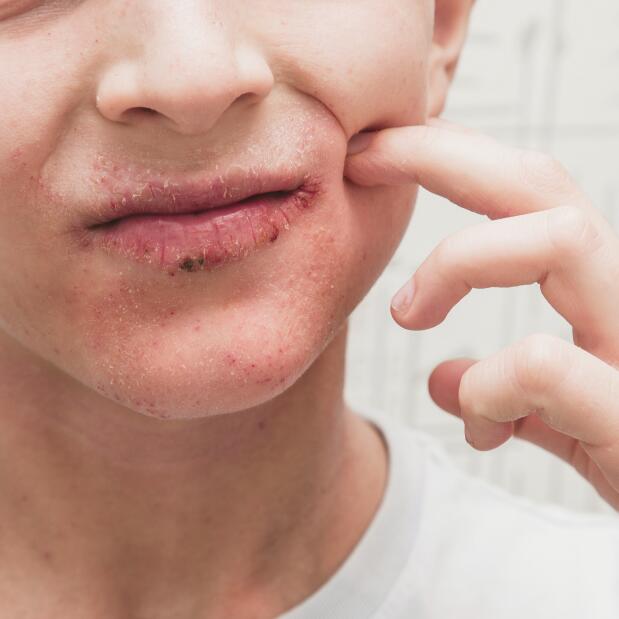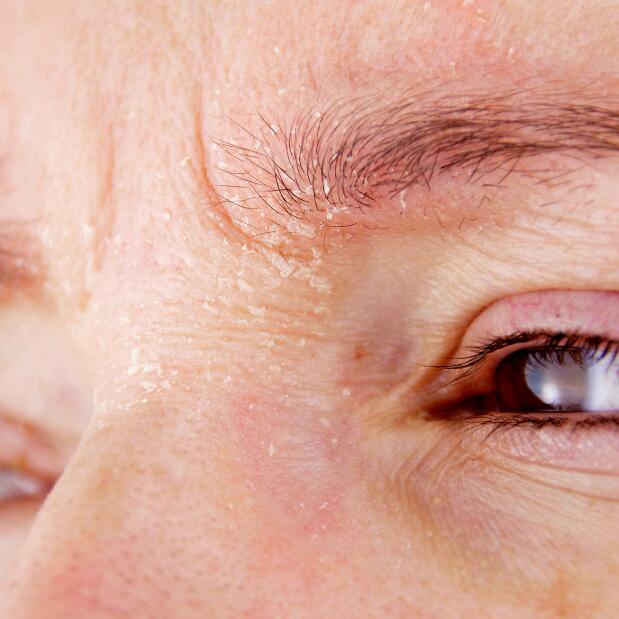Psoriasis of the face
- Living with eczema and psoriasis
- Psoriasis and eczema for children - rules for moisturising
- Psoriasis and eczema in adults: suitable hygiene
- Psoriasis and adult eczema - rules for moisturising
- Children - Care and anti-itching tips
- Psoriasis and eczema in children: suitable hygiene
- Living with eczema and psoriasis: Children
- Adults - Care and anti-itching tips
- Living with eczema and psoriasis: Adult
Psoriasis of the face
It’s not the most common location of psoriasis, but some patients may have psoriasis on the face. With a few simple measures, however, the signs of facial psoriasis can be reduced. Here are some tips.

What is facial psoriasis?
Facial psoriasis is not the most common type. It’s rare for the face to be the only site of psoriasis. Most often, facial psoriasis is actually scalp psoriasis that "spills over" onto the forehead. But this is not systematic: in children, it’s more likely to affect the eyelids and the skin around the mouth. In adults, it can also be found between the eyebrows and on the nasolabial folds—more commonly known as the smile lines
How to recognise facial psoriasis
Facial psoriasis can resemble or be combined with other skin conditions. Sebo-psoriasis, for example, is the combination of psoriasis and seborrheic dermatitis. Caused by a fungus, it also manifests itself with red patches and scales, most often on the oily areas of the face.
Trust your dermatologist, who will be able to determine the precise nature of your facial psoriasis and prescribe the appropriate treatment.

Minimising facial psoriasis
There are several ways to make facial psoriasis less visible.
Make-up
Do you know why there are so many green concealers out there? Because it’s the colour that neutralises red. Combined with a compact foundation cream, it’s perfect for camouflaging facial psoriasis. To avoid aggravating the lesions, it’s important to choose make-up products for sensitive skin that you can find in pharmacies.
These camouflaging techniques, also known as "medical or therapeutic make-up", are very useful for improving self-confidence. They can be done by both women and men and to boost their self image. But remember that this type of correction is only done on psoriasis patches. Two important steps: moisturise the face and the psoriasis patches with a cream for sensitive skin just before applying the make-up and in the evening; finish by removing the make-up with a lotion, applied with the fingertips, followed by the application of a moisturising cream.
The sun
While the wind and cold tend to encourage facial psoriasis, the sun can be good for it. If you expose yourself to the sun gradually and in moderation, and if you protect your skin well, the UV rays can reduce skin inflammation and minimise the plaques. Ask your doctor for advice.
FRIENDLY (AND EXPERT) ADVICE
Facial psoriasis is particularly sensitive in the fall and winter.
Dry skin is often a breeding ground for psoriasis and facial psoriasis in particular, especially in the fall and winter. This is due to the climatic conditions that cause dry skin when you’re outside, such as wind and cold. It can also react to sudden changes in temperature, as any stimulus can trigger a flare-up of psoriasis.
To prevent it, you don't have to bundle up your face! The first thing you can do to prevent psoriasis is to moisturise.
Best practices for facial psoriasis
Don't forget to cleanse your face and remove make-up, morning and night. Use products adapted to your facial psoriasis. They should be soap-free and gentle; opt for lotions or gels that can be applied with the fingertips to avoid the friction that comes with cotton pads, which can be too aggressive on the skin. Finish with a spray of soothing and anti-irritating thermal spring water to soften the skin. To moisturise your sensitive skin, choose emollients that will form a protective barrier against skin damage. Apply them gently and regularly and your skin will thank you!
Our solutions for facial psoriasis
Eau Thermale Avène products designed to soothe psoriasis of the face
- Avène Thermal Spring Water Spray
Thermal Spring Water
Avène Thermal Spring Water SpraySoothes - Restores the skin barrier - Calms
Which skin care routine should you adopt?
Identify what it really needs with the help of our experts and discover the most suitable skin care routine for you.

